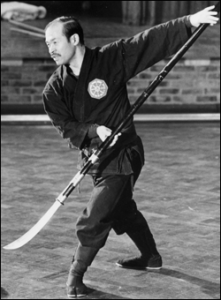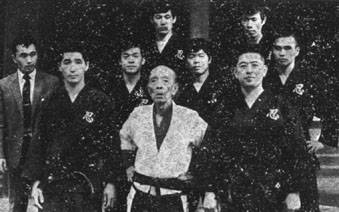The Gikan Ryu Koppojutsu is the most unknown of the arts within the Bujinkan and is often translated as ‘The School of Truth, Loyalty & Justice‘. Possibly the main reason for this is that the secret techniques were only handed down from one Soke to the next Soke, (this would often be from father to son). Gikan Ryu was founded during the Eiroku Era (1558 – 1570) by Uryu Hogan Gikanbo. He was the lord of present day Osaka (back then known as Kawachi no Kuni). His castle was known as Uryujo. He was considered a good leader and real warrior. He is seen as being an honorable martial artist who strove to keep Japan at peace. Gikanbo specialisied in Koppo Jutsu (bone breaking), Hicho Jutsu (jumping), and Senban Nage Jutsu (blade throwing). The styles of this era were normally known as: Kosshi Jutsu, Koppo Jutsu, or Daken Taijutsu.
Gikanbo was heavily influenced by the Chinese style of Cho Gyokko’s line (Gyokko Ryu Koppojutsu) and the Ikai line. From the teachings of Gikanbo comes the saying: ‘Bufu Ni Sente Nashi (From this side will not come the first strike). This is from where he developed Gikan Ryu Koppojutsu.
Gikan Ryu koppojutsu contains secret kicks, punches and throws and rumour has it that Gikanbo developed a special punch that could snap a sword in two! Grades were awarded through the traditional Japanese menkyo system using scrolls for: Shoden Gata, Chuden Gata, Okuden Gata, Kaiden Gata, and others.
The 10th Soke of Gikan Ryu had the same name as its founder, Uryu Gikanbo. On August 17th, 1863 Gikanbo fought for the Emperor during the famous battle of Tenchu Gumi no Ran. He is said to have fought valiantly, since even after being wounded by a rifle shot, he continued to attack with his one good arm until he was overcome by numerous sword cuts from the enemy. However, he was not killed and sensibly managed to retreat, despite being injured to the point of exhaustion. He retired from the battle to behind a nearby temple. There he was discovered by an Iga warrior, called Ishitani Matsutaro, who himself was on his way to join the battle. Gikanbo convinced Ishitani that the battle would be lost and that he should not waste his life. Ishitani tended to Gikanbo’s wounds and took him to Iga to recover. Ishitani Matsutaro, already the Soke of Takagi Yoshin Ryu and Kukishin Ryu, was then repaid for his kindness by being taught the Gikan Ryu, becoming the 11th generation Soke.
In the Meiji Era, when Ishitani was 61 he was given employment by the father of Takamatsu Sensei at his match factory. It was from here that Ishitani met and started teaching the young Takamatsu Sensei. Takamatsu Sensei later would receive from Ishitani the Grandmasterships of Takagi Yoshin Ryu, Kukishin Ryu, Gikan Ryu, and many others.
Takamatsu Sensei awarded the Gikan ryu to Akimoto Fumio who was his senior student. This was based through his family’s connection to the Gikan Ryu along with the Shoken Ryu of Daken Taijutsu. Unfortunately, his scrolls and densho were destroyed during the 2nd World War. Sadly, Akimoto passed away in 1962.
At this point, there are two different stories that are being told by the Genbukan and the Bujinkan.
Shoto Tanamura, the soke of the Genbukan, who was at one point a student of Hatsumi Sensei, claims to have inherited the Sokeship from Sato Kinbei who supposedly in January of 1963, was awarded the sokeship for Gikan Ryu Koppo Jutsu. As the story accounts, from this time on, any information concerning Gikan Ryu was held exclusively by Sato Kinbei Sensei in the various forms of knowledge, scrolls and texts. Kimbei Sensei for reason unknown chose to keep secret the heritage given to him by Takamatsu Sensei. Sato Kimbei is regarded by Genbukan Schools the 14th Soke of the Gikan Ryu. It was however proven in a Japanese court that Shoto Tanamura is the Soke of Gikan Ryu, and he has provided the scrolls to prove it.

Shoto Tanemura; former student of Hatsumi’s who set up his own organisation; Genbukan and the official Soke of Gikan Ryu according to the Japanese courts. This was originally contested by Hatsumi
Massaki Hatsumi’s story is less complicated – After Akimoto’s death the the Sokeship came back to Takamatsu who gave it to Hatsumi along other eight Ryus that all together were used to create the Bujinkan Budo Ninpo Taijutsu School. However, when asked he has not provided any scrolls to prove that this is the case. It may well be that there is more than one sokeship for the Gikan Ryu that has been given, none-the-less, it is almost completely unaccessible to the general public or even senior practitioners of the Bujinkan. The only real way to study the Gikan Ryu is through the Genbukan, where the scroll has been given to the public.
However, on 28th February 2015, I had the great fortune to attend a seminar on Shidenfudo Ryu Dakentaijutsu lead by Dr. Kacem Zoughari. Kacem had just recently been allowed access to a few scrolls and densho from Soke Masaaki Hatsumi’s personal library, and one of the scrolls that he brought to show us in the UK was a never before seen scroll of sword on sword techniques within the Gikan Ryu. What was particularly unique about this scroll was that as well as the kanji detailing the technique, the illustrations of various kamae were quite beautiful and very colourful. Most scrolls have no illustrations or few, and those that do are not often coloured. This was a very nice exception to that rule. It also proved that Soke Hatsumi does have quite a few scrolls that until now he has not shared with people, or at least only a trusted few. This scroll also detailed that one of the defining characteristics of the school is for the feet to be pointing in completely opposite directions, like a ballet stance, which alone makes any technique very difficult.
Ultimately though, the strong influence of the Gyokko Ryu upon the Gikan Ryu, means one can assume that the differences between the two are not very big. Therefore studying the Gyokko Ryu is probably as close as we will get within the bujinkan to understanding the essense of the Gikan Ryu.



Fantastic insights Fane San
Ninpo-Ik-kan